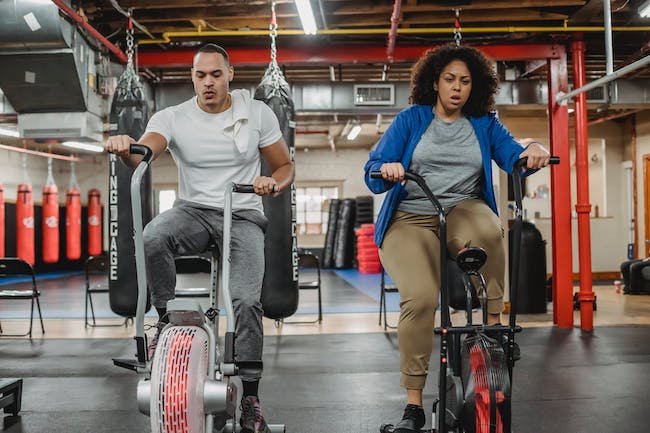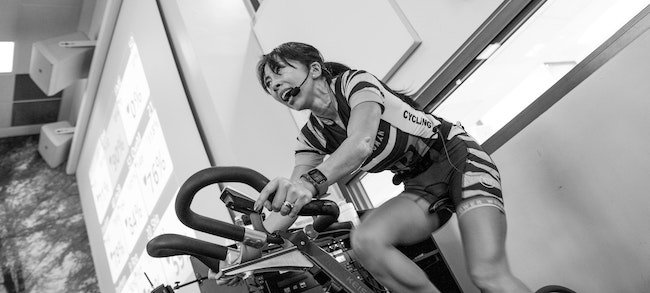
Today we’re looking at how long you should ride a stationary bike to lose weight.
I originally posted this article - on another platform - on my long cycling health and fitness website. I thought it was worth sharing here.
It is safe to assume that the same results apply to regular, outdoor, cycling. And if not exactly the same then at least very similar results occur. In any case, let’s get started.
**It is commonly understood that 3500 calories equals 1 pound of weight. **
A person weighing 155 pounds can ride a stationary bike at a moderate rate for 30 minutes and may burn 260 calories. This person could potentially lose 1 pound of weight with approximately 7 hours of moderate stationary biking.
**That same person could ride a stationary bike at a vigorous rate for 30 minutes and may burn 391 calories. In that case, this person could potentially burn 1 pound of weight with about 5 hours of vigorous stationary biking. **
That said, none of it is exact science. There are many varying factors and (based on my own failures in this area) you more-or-less need a plan to succeed.
And, if we’re to succeed, our plan needs to be a logical and practical strategy.
When it comes to our weight loss strategy there are a number of elements we should keep in mind. These are strength training, intensity, duration and one critically important component we absolutely cannot skip over or ignore – diet.
Diet
Point-blank, the truth is that just doing exercise will not automatically mean you will lose weight.
You need to be sure you’re eating and drinking properly, not overcompensating, not snacking and not stuffing your face with junk all the time.
You are what you eat.
I’m sure you’ve heard that old cliche before. But it is true, what you eat does matter. If you mostly consume fat-making foods and drinks then that’s what your body will become. Fat.
Here’s another phrase that should be over used; Weight loss is 75 percent what you eat and 25 percent exercise.
Yes, it is awesome that you just burned 500 calories on your indoor bike, but it will be all pointless if you then eat a bunch of carbs and processed foods that equate to 900 calories and still doesn’t fill you up.
Our meals should consist primarily of whole foods. I’m thinking protein, fresh vegetables, nuts and some fruits. You already know this, I know.

Tackling the issue
In my case, eating healthy, eating right is the part I struggle with the most and – as I am learning – the reason why despite my years of cycling I still have too much fat.
And as I get older that body fat scares me because it can lead to so many serious health issues.
Anyway, I have been making some changes and I am trying to eat healthier foods now but eating right is still challenging.
While looking into strategies to help me eat better I came across intermittent fasting (IF) and started trying it out. This is something that makes sense to me and that I am trying to fully incorporate into my life.
So far so good!
I’ve been doing IF for a short while and I do see results.
Before going any further though, I’ll make it clear; I am not a doctor or nurse or dietician or any sort of healthcare provider or medical expert whatsoever.
I am not telling you or recommending that you do like me.
You should do your own research. And now let’s move on.
Intermittent fasting
If you’re interested in researching and learning more about intermittent fasting then maybe you can start with Dr. Jason Fung.
He offers a no-nonsense, logical and practical approach to this lifestyle and his YouTube videos could be where you begin your research.
Again, it’s worth repeating that I am not an expert in any health-related field. It’s best that you do your own research.
Duration
The amount of time you spend cycling in a single session obviously matters. The longer you go, the more your heart pumps, the more you breathe, move and sweat.
It’s an effective component to our weight loss strategy.
This is especially relevant if you are pedalling at a moderate intensity.
If we work with the example provided at the top of this post, a 155 pound person riding a stationary bike for 30 minutes at a moderate rate will burn about 260 calories.
However, we can then assume that adding 30 minutes to the ride, making it a 60 minute ride, will mean that 520 calories get burned – as long as the moderate intensity continues.
The longer you go the more fat you burn.
Intensity
If you’re breathing hard, you’re burning fat.
As I understand it, the reason aerobic exercise is fat-burning is because your body burns fat via oxidation.
Basically the process of losing fat entails metabolizing the triglycerides stored in your fat cells which you then exhale as carbon dioxide (the resulting waste product) while you breathe.
And so, upping the intensity higher – enough to be breathing hard – means you will lose more fat.
Increasing the intensity is definitely one of the elements needed in our weight loss plan.
Looking again at the example above, the 155 pound person riding for 30 minutes at a moderate rate loses about 260 calories. Right?
BUT if that same person increases the intensity to a more vigorous rate then – for the same 30 minute period – 391 calories are burned.
Comparing results
Individual: 125 pound / 155 pound / 185 pound
Stationary cycling - **moderate: **210 calories burned / 260 calories burned / 311 calories burned
Stationary cycling - **vigorous: **315 calories burned / 391 calories burned / 466 calories burned
The higher the intensity (which means you’ll be breathing harder) means more calories get burned.
And that’s why high intensity interval training (HIIT) is so effective.

HIIT
High-Intensity-Interval-Training, also known simply as “HIIT”, is a popular and effective calorie-burning strategy.
It entails adding short and intense efforts to your workout routine in order to burn more fat. You can either make it a workout all on its own or it can be incorporated into your usual session.
Studies on HIIT have actually been done to show its effectiveness.
For example, the University of Western Ontario found that cyclists doing four to six 30-second – at full sprint – 3 times a week burn more than twice as much body fat as cyclists who ride for 30 to 60 minutes at a moderate (aerobic intensity) rate
There’s more to it so feel free to do your own research but the fact is high intensity interval training is a scientifically-proven fat burning tool.
On a related note, I recently tried HIIT while using an elliptical machine and, well, I have to admit that after the third “sprint” I was completely out of gas and huffin’ & puffin’ like crazy.
HIIT might not be for everyone but it could be for you.
Strength training
The final component to our weight loss strategy is strength training; lifting weights.
Let’s imagine that we are eating right and doing cardio. The fat is burning off and we’re losing weight. Unfortunately, this weight loss can be a combination of fat and muscle.
It’s true that the resistance part of cycling will build your calves, quads and glutes, however, you have to do more to counteract the broad muscle loss that can happen over time if you simply focus on the stationary bike to lose weight.
There are definite advantages to preventing muscle loss and building muscles. For example, losing muscle will slow your metabolism which in turn will make it even more challenging to burn fat.
A lack of muscle will also mean that you can’t pedal as hard or last as long as you want to go. You just won’t have the power to do it.
Part of our weight loss plan should include lifting weights 2 or 3 days a week. It will speed up your metabolism, build lean muscle, make you stronger and most importantly improve your health.

Conclusion
How long should you ride a stationary bike to lose weight?
The straight answer is that you can ride your stationary bike at a moderate rate for 7 hours and lose 1 pound of weight. Or you can ride at a vigorous rate for 5 hours to lose the same amount of weight.
But, in my opinion, on it’s own this is not a very good weight loss plan.
If someone is serious about losing weight the most important component to the weight loss strategy is diet. Eating right. Eating smart.
To make sure we stay as healthy as possible, our weight loss strategy should incorporate strength training, keep in mind intensity and duration and most importantly we absolutely cannot skip over or ignore – diet.
In my own case, my mistake is not realizing that eating right trumps everything else when it comes to weight loss.
Source
++https://www.health.harvard.edu/staying-healthy/no-time-to-exercise-then-take-five++
++https://www.mayoclinic.org/healthy-lifestyle/weight-loss/in-depth/calories/art-20048065++
++https://www.health.harvard.edu/newsweek/Calories-burned-in-30-minutes-of-leisure-and-routine-activities.htm++
++https://www.health.harvard.edu/blog/intermittent-fasting-surprising-update-2018062914156++
That’s a really long time for so few calories…
I’ll eat less chips….
!PIZZA
Yep! If you want to lose weight and plan on doing it only through exercise you'll be doing it for a long time.
People don't understand the importance of keeping in mind what we consume. I was the same. For years I thought that if I worked out I'd lose fat / weight and I could keep on eating like always. I was wrong.
Eating less chips helps. So does (for me) intermittent fasting.
PIZZA Holders sent $PIZZA tips in this post's comments:
@amyx(2/5) tipped @flaglesscanuck (x1)
Learn more at https://hive.pizza.